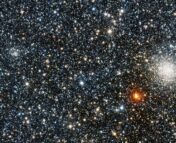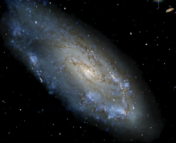Title: Subaru/FOCAS IFU revealed the metallicity gradient of a local extremely metal-poor galaxy
Authors: Yuri Kashiwagi, Akio K. Inoue, Yuki Isobe, Kimihiko Nakajima, Masami Ouchi, Shinobu Ozaki, Seiji Fujiimoto, Yoshiaki Ono, Takashi Kojima
First Author’s Institution: Department of Physics, School of Advanced Science and Engineering, Faculty of Science and Engineering, Waseda University, Okubo, Shinjuku, Tokyo; Institute for Cosmic Ray Research, The University of Tokyo, Kashiwanoha, Kashiwa,
Chiba; Department of Physics, Graduate School of Science, The University of Tokyo, Hongo, Bunkyo, Tokyo
Status: Accepted for publication in the Publications of the Astronomical Society of Japan
Growing Galaxies
Galaxies in the universe grow and evolve predominantly through star formation. Therefore, understanding where and from what gas the stars form gives detailed insights into the evolution of galaxies. One important quantity to measure here is the metallicity gradient in a galaxy. By measuring how the metallicity (or how rich the gas is in elements heavier than helium) changes within a galaxy, we can understand how galaxies may have formed their stars.
There are two possible metallicity gradients that can be seen in a galaxy. A negative gradient, where the metallicity is higher towards the nucleus, indicates that star formation begins in the center of a galaxy and propagates outwards. Conversely, a positive gradient suggests that unprocessed gas from the circumgalactic medium has been accreted and formed into stars on the outskirts of a galaxy first.
However, to-date no studies have been done on the metallicity gradients in extremely metal-poor galaxies (EMPGs). EMPGs are defined as galaxies with a metallicity of roughly 10% of the solar value or less (or value of 12+log(O/H) = 7.69 in astronomer’s terms). These galaxies are very important as analogs towards understanding some of the very first galaxies to form in the high-redshift universe.
Tracing Metals
The authors of today’s paper targeted the EMPG HSC J1631+4426 with Subaru FOCAS. Subaru is an 8.2-m reflecting telescope located on Maunakea, with a wide range of instruments in the optical and near-infrared. FOCAS, or the Faint Object Camera and Spectrograph, allows for observations in the optical wavelengths. Using the Subaru Hyper Suprime-Cam, this galaxy was discovered to have a very low metallicity of 12+log(O/H) = 6.90 (1.6% of the solar metallicity) and a low mass of log(Msun/M) = 5.8 at a redshift of z = 0.03125. With FOCAS in integral field unit (IFU) mode, the authors are able to make a measurement of the spectrum of the galaxy at different physical locations.
With a spectrum in each spatial pixel (spaxel), the authors measured the emission lines needed to constrain the metallicity of the gas in a specific region of the galaxy. With metallicities in each spaxel, the authors then created a map of metallicity. A projection of this map into metallicity vs. radius space is shown in Figure 1. Clearly visible is a negative trend from the central regions of the galaxy to the outer regions.

After binning the data in several radius bins, the authors fit the trend using a linear model and found a gradient of -0.36 ± 0.04 dex/kpc. A comparison of this value to other metallicity gradients can be seen in Figure 2. The gradient of HSC J1631+4426 is significantly steeper than any of the comparison galaxies. It is important to note that all of the comparison galaxies have central metallicities at least 1 dex higher and stellar masses at least 3 dex higher than the EMPG studied here.

Back in Time
Today’s paper represents the first measurement of a metallicity gradient in an EMPG. Some predictions for the low bulk metallicities of EMPGs suggest accretion of cold gas from the cosmic web, resulting in positive metallicity gradients, in contrast to the gradient measured here. As such, further studies of EMPGs will be important not only to understanding the diversity of behaviors but also to establish a well-studied set of analogs with which to compare to newly-discovered high-redshift galaxies from JWST.
Astrobite edited by Suchitra Narayanan
Featured Image Credit: NASA




